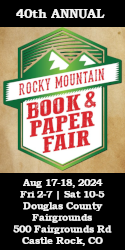Books, Publishing and Hard Times
In many ways traditional bookselling and publishing have been anticipating economic trouble long before the markets and the general public became involved.
In the case of the New York Times, they’re facing a double challenge, according to Michael Hirschorn’s piece in the current issue of The Atlantic (January/February 2009). Even though metropolitan daily newspapers everywhere have been cutting production schedules, reducing page size, and eliminating costs at every turn, those that remain must now deal with the crisis in the financial system. “...reports released by the New York Times Company in October indicate that drastic measures will have to be taken over the next five months or the paper will default on some $400 million in debt. With more than $1 billion in debt already on the books, only $46 million in cash reserves as of October, and no clear way to tap into the capital markets (the company’s debt was recently reduced to junk status), the paper’s future doesn’t look good...”
To say that journalism has changed is a bit of an understatement. I think we can look forward to more consolidation, increased use of wire services, and other forms of cooperation that will eliminate more of the salaried positions currently held by staff writers and reporters. Some of the big newspaper names will remain, but the news emphasis and editorial content may become more standardized than it already is. Names like Carlos Slim and Rupert Murdoch are among those mentioned as potential suitors in search of journalistic trophy properties and in a recent piece in the Financial Times Carlos Slim is reported to be seeking a 17% stake in the New York Times. Why he or anyone would loan the company an additional $250 million (in addition to the shares he already owns) to eventually become the paper’s largest individual stockholder, but without having more control of the voting shares, is somewhat puzzling.
Last time we mentioned the migration of Fine Books & Collections from paper to the Internet, although the printing of an anuual remains a distinct possibility according to their website. Now it seems that another shoe has dropped and Rare Book Review (which began life in the early 1970s as Antiquarian Book Monthly Review or ABMR, under the ownership and editorial direction of Paul Minet) is about to or has already stopped publication. For more about this, read Mr. Minet’s latest “Letter from England”.
We’ve had some inquiries about whether this magazine will continue to publish in paper format or whether we’ll eventually join the long march to the Internet. We’re fortunate in having a solid band of loyal subscribers (many of whom have been with us since the 1980s) who have a strong bias in favor of reading words on paper and who encourage us to stay the present course. We also hear from others who have been “thinking about” subscribing for a long time, are still thinking about it, and in the meantime would we mind very much mailing them a free sample of the latest issue that they weren’t able to pick up at the last book fair.
Long ago we simply accepted that this was part of the demographic—especially as it relates to the more marginal members of the trade—and we’ve learned to live with it. Of course there are many other factors in play as well, and ultimately the market, along with production and distribution costs, will make the decision for us.
*
Our own book club (see the “Book Clubs” link on our website) just finished reading and discussing Studs Terkl’s Hard Times, an anecdotal history of the Great Depression in the words of hundreds of people who lived through it and told their stories to Terkl in the late ’60s. Nearly 40 years after publication (1970) it remains eerily relevant in today’s economic climate.
Besides the tales of hardship, there were pockets of economic activity where some people and businesses not only survived but prospered. One of the people interviewed by Terkl was William Benton of Benton and Bowles, an advertising agency that made its fortune during the 1930s—in subsequent careers William Benton published the Encyclopedia Britannica and became a U.S. Senator from Connecticut, while his former partner Chester Bowles served in various diplomatic posts including Ambassador to India and Under Secretary of State during the late ’50s and ’60s.
The threat of an “ugly deflation” that worries some economists wouldn’t be a bad thing if prices on goods and services declined more or less uniformly. (Inflation is generally favored by tax collectors, central bankers and promoters of other speculative bubbles). A few weekends ago we attended an antique show in Syracuse (NY) and apart from the fact that there were larger crowds compared to the two previous years, I had a conversation with one of the dealers about the general state of the economy. He pulled a handful of change from his pocket, mainly dimes and quarters, and allowed as how he was still able to buy gasoline for about 30 cents a gallon. I looked closely and saw the dimes and quarters were all from the pre-1964 period. Apparently he had saved a huge stash from the early 1960s and had hooked up with a gas station owner who accepts them based on the current market value for silver coinage. I suppose you could say this was speculation of a different sort.
Marvin Mondlin, co-author with Roy Meador of Book Row (NY, Carroll & Graf, 2004), remembers the 1930s very well and not long ago he reminded me that at the time the area along Fourth Avenue, near where he lived and worked for so many years, was the bookhunter’s happy hunting ground. Books were plentiful and cheap, and without as many competing distractions people apparently read more in those days. Of course it didn’t hurt that street-level premises could sometimes be rented for as little as $40.00 a month. It was a magical combination of circumstances that made it a sort of golden age for secondhand bookselling, although some of the curmudgeonly proprietors would probably never have admitted it.
Before his retirement a few years back, Marvin ran the rare book department of the Strand Bookstore at 828 Broadway, not far from where that venerable institution began life as the Pelican Bookshop on 8th Street in1927. As far as I know Marvin, who moved to Roosevelt Island after his retirement, still has what is probably the largest privately-owned archive of photographs and ephemera related to antiquarian bookselling in lower Manhattan. And if I understand him correctly, he’s of the opinion that the present economy may ultimately help the secondhand book trade.
You may have noticed that waste and mindless consumption is no longer fashionable while careful and thoughtful spending is. Since living within one’s means is less a lifestyle choice and more of a necessity these days, the secondhand book trade is again well-positioned to take advantage of hard times. Having said that, I don’t mean to suggest that booksellers will again be rushing to take premises along Fourth Avenue or in any of the great population centers—the urban real estate market and property taxes have made sure that won’t happen. The shift to the Internet will continue and those “bricks and mortar” bookshops that choose to remain such will probably continue to seek out lower rents in more rural or suburban settings.
Paul Padgette, who has been lamenting the disappearance of bookstores from his city for some time, sent me a clipping from the San Francisco Chronicle (January 7th) that announced the impending closure of yet another bookstore—Stacey’s, a Market Street bookselling landmark for 85 years. I personally don’t see this as a reflection of the reading habits of San Franciscans, but more the inevitable result of the rising costs of urban retail locations and the shrinking pool of shops (of whatever type) able to afford them.
Willis Monie Books in Cooperstown (NY) attracts a fair amount of traffic during the summer baseball season when tourists are in town, but during the rest of the year relies on Internet sales. At any one time they have about 85,000 books listed on the searchable databases (i.e. Biblio.com) and on their own website, and they ship an average of 75 books a day. Willis Monie is one of many booksellers whose collections can be browsed by going to the Booksellers’ Gulch page of this magazine’s website. Because the rent’s free, Booksellers’ Gulch is a sensible option for booksellers wanting to control overhead costs while having access to the global market. This morning, for example, I used it to order a book and paid less (even with shipping) than I would have for a new copy at one of the chain bookstores or on Amazon.
Lately, I’ve noticed, book clubs have been shifting emphasis from current “best sellers” to older books, both in and out of print. Our own club’s current selection is “Nicholas Nickleby” and because good clothbound copies are readily available in the secondhand book trade, many of our members have been getting into the habit of going to the Internet rather than drive 20 miles to the nearest Barnes & Noble. The convenience of the Internet and the current economic climate have combined to create circumstances potentially favorable to the secondhand book trade. How the trade takes advantage of the situation is another matter.

























